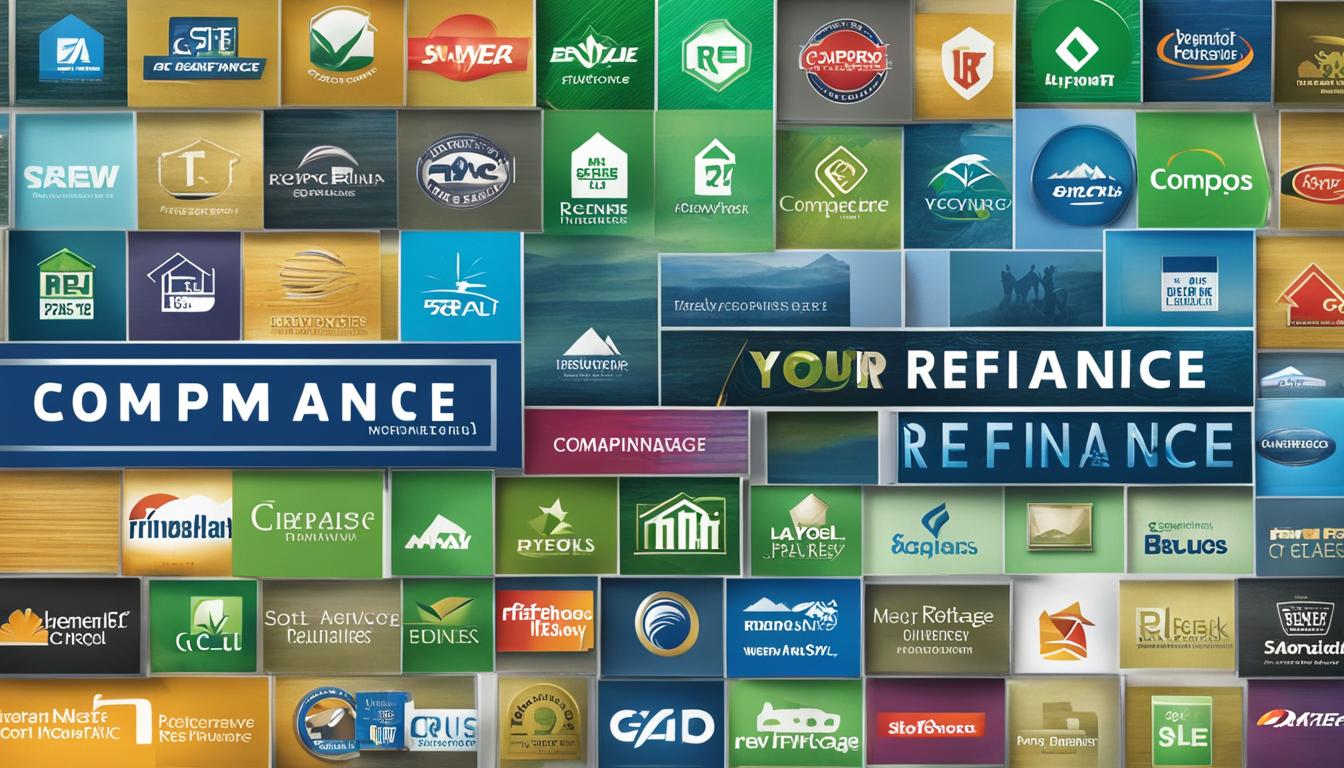Simplify Your Mortgage Journey to Comparing the Best Refinance Companies for Your Mortgage Needs
Refinancing your mortgage can be a complex process, but with the right guidance, you can find the best refinance companies to meet your needs. This article will provide a step-by-step guide to help you navigate the process and compare the top refinance companies in the market.
Key Takeaways:
- Assess your financial situation, including your credit score, income stability, and debt-to-income ratio (DTI)
- Determine your refinancing goals, such as lowering monthly payments, obtaining a lower interest rate, or shortening the loan term
- Evaluate your current mortgage, including the interest rate, monthly payments, and any associated fees or penalties
- Shop around for the best rates and terms by comparing multiple lenders and considering both interest rates and closing costs
- Gather all necessary documentation, such as income statements, tax returns, and employment verification, before applying for a new loan
Assess Your Financial Situation
Before starting the refinancing process, it’s important to take a close look at your financial situation to determine if refinancing is the right option for you. This involves assessing several key factors, including your credit score, income stability, and debt-to-income ratio (DTI).
Check Your Credit Score
Your credit score plays a significant role in determining your eligibility for refinancing and the interest rate you’ll receive. A higher credit score generally translates to better loan terms and lower interest rates. Take the time to review your credit report and address any errors or negative items. Improving your credit score before refinancing can potentially save you thousands of dollars over the life of your loan.
Evaluate Income Stability
Lenders typically want to ensure that you have a stable income to make timely mortgage payments. Assess your job security and evaluate the stability of your income sources. If you’re self-employed or have irregular income, providing consistent proof of income may be necessary to demonstrate your ability to repay the refinanced loan.
Calculate Your Debt-to-Income Ratio (DTI)
Your DTI is the percentage of your monthly income that goes towards paying debts. Lenders use this ratio to assess your ability to handle additional debt. Ideally, a lower DTI indicates a lower credit risk. Calculate your DTI by adding up your monthly debt payments (including credit cards, car loans, and other loans) and dividing this total by your gross monthly income. It’s generally recommended to maintain a DTI below 43% to increase your likelihood of refinancing approval.
Assessing your financial situation is crucial before embarking on the refinancing journey. It allows you to understand your creditworthiness, evaluate your income stability, and determine if refinancing aligns with your financial goals.
Determine Your Refinancing Goals
Once you have assessed your financial situation, it’s time to determine your refinancing goals. This step is crucial as it will guide you in finding the most suitable refinance options. Here are some common refinancing goals to consider:
- Lower monthly payments: If your current mortgage is putting a strain on your monthly budget, one of your goals may be to lower your monthly mortgage payments. By refinancing, you may be able to secure a lower interest rate or extend the loan term, resulting in more manageable payments.
- Obtain a lower interest rate: Another common refinancing goal is to secure a lower interest rate. A lower interest rate can potentially save you thousands of dollars over the life of your loan.
- Shorten the length of your loan: If you’re looking to pay off your mortgage sooner, shortening the loan term may be your goal. Refinancing to a shorter loan term can help you build equity faster and save on interest payments.
- Switch from an adjustable-rate mortgage to a fixed-rate mortgage: If you currently have an adjustable-rate mortgage (ARM) and are concerned about rising interest rates, switching to a fixed-rate mortgage may be a goal. A fixed-rate mortgage provides stability with consistent monthly payments throughout the loan term.
Identifying your refinancing goals will help you communicate with lenders and find the best refinance options that align with your needs. It’s important to keep your goals in mind as you evaluate different loan offers to ensure they meet your desired outcomes.

Remember, refinancing your mortgage is a significant financial decision, so take the time to carefully consider your goals and the potential benefits before moving forward.
Evaluate Your Current Mortgage
When considering refinancing your mortgage, it’s important to thoroughly evaluate your current mortgage to determine if it’s the right time to make a change. Start by examining key factors such as your interest rate, monthly payments, and remaining loan balance. This information will give you a clear picture of your current financial situation and help you make an informed decision.
Interest Rate: The interest rate on your mortgage is a significant factor that affects your monthly payments and the total amount you’ll pay over the life of your loan. Check your current interest rate and compare it to current market rates. If interest rates have dropped since you obtained your mortgage, refinancing may be a viable option to secure a lower rate and potentially save money in the long run.
Monthly Payments: Review your monthly mortgage payments to assess their affordability and alignment with your financial goals. Are the payments within your budget, or do they strain your finances? If your monthly payments are causing financial stress, refinancing may provide an opportunity to lower your payments and increase your cash flow each month.
Remaining Loan Balance: Take note of the remaining balance on your mortgage. Refinancing can help you pay off your mortgage earlier if you shorten the loan term or reduce the interest rate. On the other hand, if you’ve been making mortgage payments for several years, refinancing to a new 30-year loan might reset the clock and increase the overall interest you’ll pay.
Aside from these key factors, thoroughly read the terms and conditions of your current loan. Look for any fees or penalties associated with refinancing or early repayment. It’s essential to calculate the break-even point to evaluate the financial benefit of refinancing. This point represents the time it takes to recoup the costs of refinancing through the potential savings you’ll gain from a lower interest rate or reduced monthly payments.
Did You Know? Refinancing to a lower interest rate might not always be the best option if you don’t plan on staying in your home for a long period. It’s crucial to consider the closing costs associated with refinancing and determine if the savings you’ll gain justify the upfront expenses.
Example Break-Even Calculation
Let’s suppose your refinancing costs $3,000, and it reduces your monthly mortgage payment by $100. This means it will take 30 months ($3,000 divided by $100) to recoup the upfront costs and start benefiting from the lower payments. If you plan to stay in your home for longer than 30 months, refinancing could be a financially sound decision.
Current Mortgage Evaluation Summary
| Factor | Details |
|---|---|
| Interest Rate | 3.75% |
| Monthly Payments | $1,200 |
| Remaining Loan Balance | $200,000 |
By thoroughly assessing your current mortgage, including interest rate, monthly payments, and loan balance, you’ll gain valuable insights into whether refinancing is a viable option for you. Remember to consider the potential savings, break-even point, and any associated fees or penalties. Armed with this information, you can confidently proceed to the next step of your mortgage refinance journey.

Shop Around for the Best Rates and Terms
When it comes to refinancing, it’s essential to shop around and compare rates and terms offered by multiple lenders. While interest rates play a significant role in your decision, it’s equally important to consider the overall cost of the loan, including closing costs and fees.
Contact different lenders to gather quotes and evaluate their offers. Be sure to inquire about their customer service to ensure a smooth refinancing experience. Checking their reputation and reading reviews from other borrowers can provide valuable insights into the lender’s reliability and transparency.
Additionally, inquire about options for rate locks. A rate lock allows you to secure a specific interest rate for a certain period, protecting you against potential interest rate increases during the application process. This can be particularly beneficial if you anticipate a rise in interest rates.
Remember, each lender may have different criteria and requirements, so it’s essential to consider them all before making a decision.
Comparison shopping is key when refinancing. Don’t settle for the first offer that comes your way. Take the time to explore multiple lenders to find the best rates and terms that suit your needs.
Gather Necessary Documentation
To streamline the refinancing application process, it’s important to gather all the necessary documentation beforehand. When applying for a mortgage refinancing, you’ll need to provide various documents to lenders to verify your financial standing and eligibility. By preparing these documents in advance, you can expedite the application process and increase your chances of approval.
The necessary documentation typically includes:
- Income Statements: These documents provide proof of your income and may include recent pay stubs, W-2 forms, or income tax returns. Lenders use this information to assess your financial stability and ability to repay the refinanced loan.
- Tax Returns: Your tax returns for the past two years offer a comprehensive overview of your financial situation. Lenders often consider your tax returns to verify your self-employed income and assess your overall financial health.
- Employment Verification: Providing employment verification, such as a letter from your employer or recent pay stubs, confirms your current employment status and helps lenders evaluate your income stability.
- Bank Statements: Lenders require your bank statements to verify your cash reserves and ensure you have sufficient funds for closing costs or other fees associated with the refinancing process.
- Proof of Homeowners’ Insurance: Lenders typically require proof of homeowners’ insurance to protect their interests and ensure your property is adequately covered.
- Property Tax Payments: Providing proof of property tax payments helps lenders understand your financial obligations related to your home and assess your ability to manage the additional costs associated with homeownership.
Gathering these documents early on will save you time during the application process, preventing delays and potential back-and-forth requests from lenders. It’s important to ensure that all the required documents are up to date, accurate, and easily accessible for submission. By being prepared, you can move forward confidently in pursuing your mortgage refinancing goals.
| Required Documentation | Details |
|---|---|
| Income Statements | Recent pay stubs, W-2 forms, or income tax returns |
| Tax Returns | Completed tax return forms for the past two years |
| Employment Verification | Letter from employer or recent pay stubs |
| Bank Statements | Recent statements to verify cash reserves |
| Proof of Homeowners’ Insurance | Valid insurance policy covering the property |
| Property Tax Payments | Receipts or proof of property tax payments |
Apply for a New Loan
Now that you have identified the right loan for your needs, it’s time to submit your new loan application to the chosen lender. The application is the first step in the approval process, where the lender will carefully review your documents and verify the information provided. This ensures that all the required details are in place for a smooth refinancing process.
One crucial step in the approval process is the home appraisal. The lender will conduct a thorough evaluation of your property to determine its current market value. This helps in calculating the loan-to-value (LTV) ratio, which is essential for approving your refinance application. The home appraisal ensures that the loan amount aligns with the property’s worth, providing security for both you and the lender.
Submitting a complete and accurate new loan application, along with supporting documentation, increases your chances of approval. The lender will assess your financial stability, income, creditworthiness, and the property’s value before making a decision. It’s important to provide all the necessary information and answer any additional queries promptly to expedite the approval process.
“The new loan application is your gateway to securing a better mortgage. Make sure to submit all required documents and be responsive to any additional requests from the lender. This will help ensure a smooth and efficient approval process.”
Throughout the application and approval process, open communication with your lender is vital. Stay informed about the progress and ask any questions that may arise. This will help you understand the status and timeline of your application and address any concerns promptly.
Once your new loan application is approved, you’ll be one step closer to achieving your refinancing goals. The final stage of the refinancing journey is closing on your new loan, which involves reviewing and signing the necessary paperwork and paying any associated fees. With each step, you’re getting closer to securing better terms and saving on your mortgage.
Close on Your New Loan
Once your refinance application is approved and the interest rate is locked, it’s time to move forward with closing on your new loan. This is the final step in the refinancing process, where you’ll review and sign all the necessary paperwork and take care of associated fees.
During the closing, you’ll work with your lender to go through the loan documents in detail. It’s important to carefully review everything and ask any questions you may have. This is your opportunity to ensure that you understand the terms and conditions of your new loan.
In addition to the paperwork, you will need to pay any closing costs and fees associated with the refinancing. These fees may include appraisal fees, loan origination fees, title search fees, and other charges. It’s essential to have a clear understanding of the total cost of refinancing your mortgage.
Once the closing is complete, your lender will handle paying off your old mortgage, and you’ll begin making payments on your new loan. This marks the start of your journey with improved terms and conditions that best suit your financial future. Take pride in successfully navigating the refinancing process and securing a better outcome for your mortgage.
FAQ
How do I assess my financial situation before refinancing?
To assess your financial situation, check your credit score, evaluate your income stability, and calculate your debt-to-income ratio (DTI).
What are common refinancing goals?
Common refinancing goals include lowering monthly payments, obtaining a lower interest rate, shortening the loan term, or switching from an adjustable-rate mortgage to a fixed-rate mortgage.
What should I consider when evaluating my current mortgage?
When evaluating your current mortgage, consider the interest rate, monthly payments, remaining loan balance, and any terms and conditions, such as fees or penalties for early repayment.
How can I find the best rates and terms when refinancing?
To find the best rates and terms, shop around and compare offers from multiple lenders. Consider not only the interest rate but also the overall cost of the loan, including closing costs and fees.
What documentation do I need when refinancing?
Typically, lenders require income statements, tax returns, employment verification, bank statements, proof of homeowners’ insurance, and property tax payments.
How do I apply for a new loan when refinancing?
To apply for a new loan, submit your application to the chosen lender. They will review your documents, verify your information, and conduct a home appraisal to determine the current value of your property.
What is involved in closing on a new loan?
Closing on a new loan involves reviewing and signing all necessary paperwork and paying associated fees. The lender will pay off your old mortgage, and you’ll begin making payments on your new loan.
